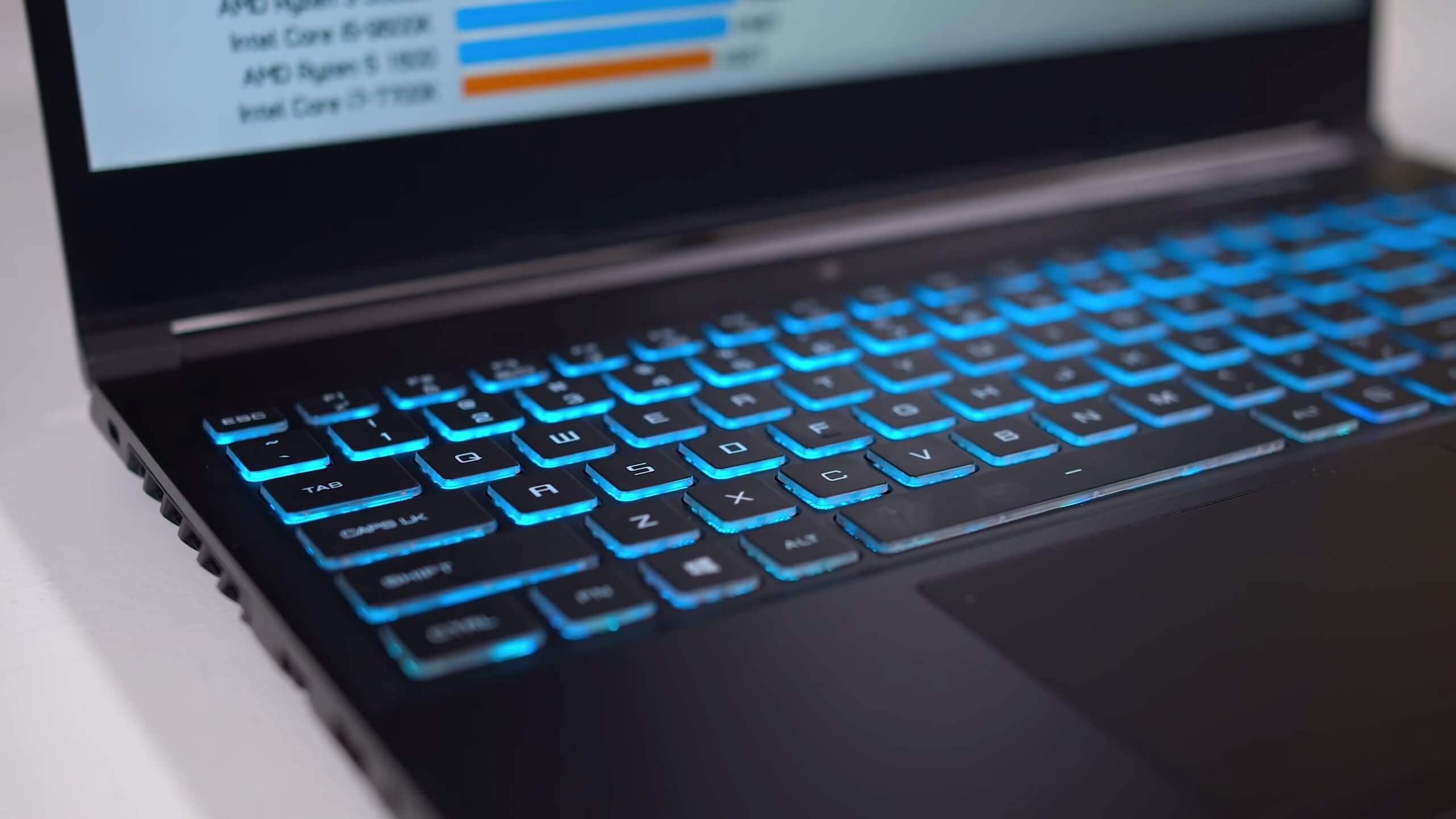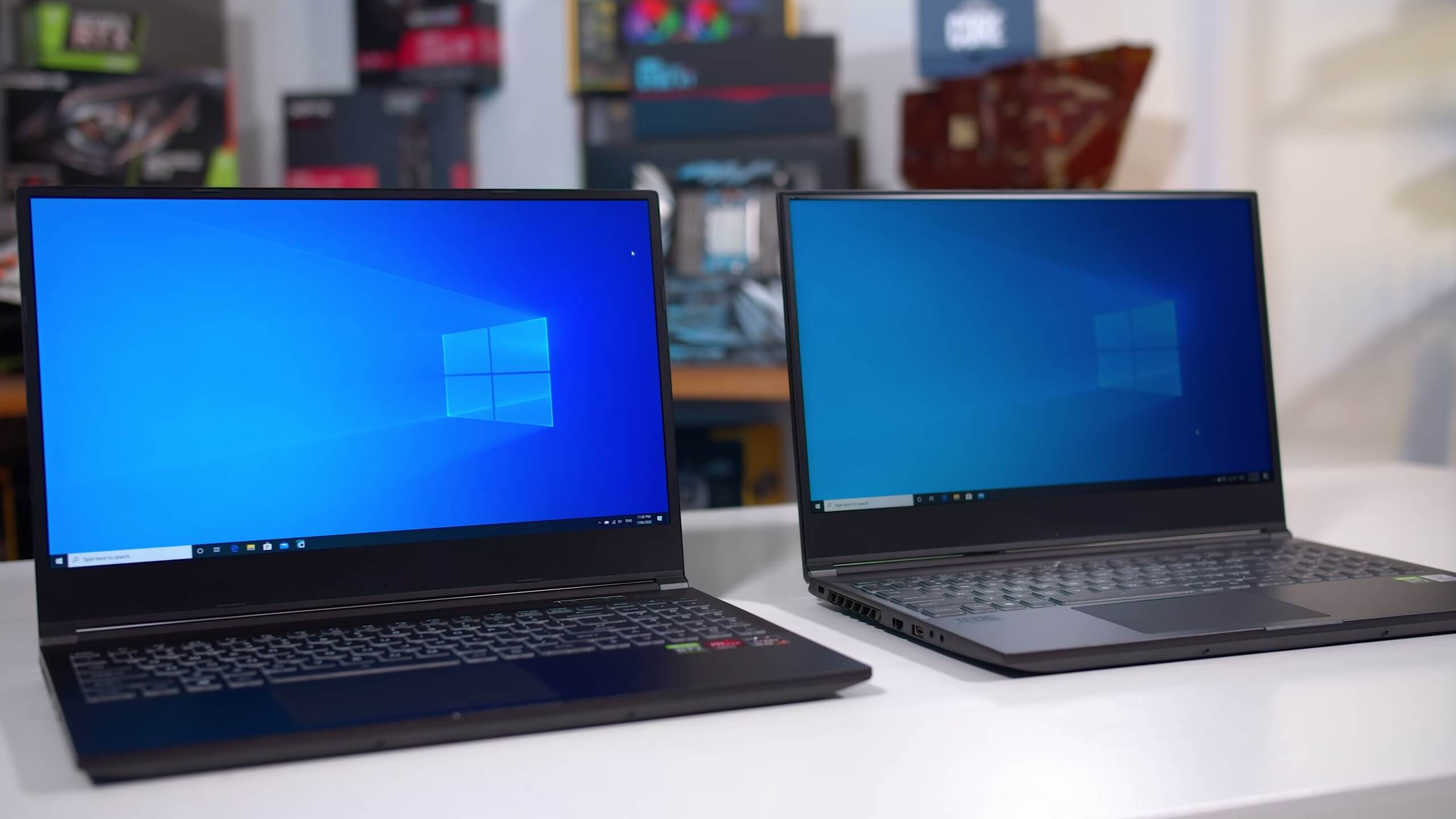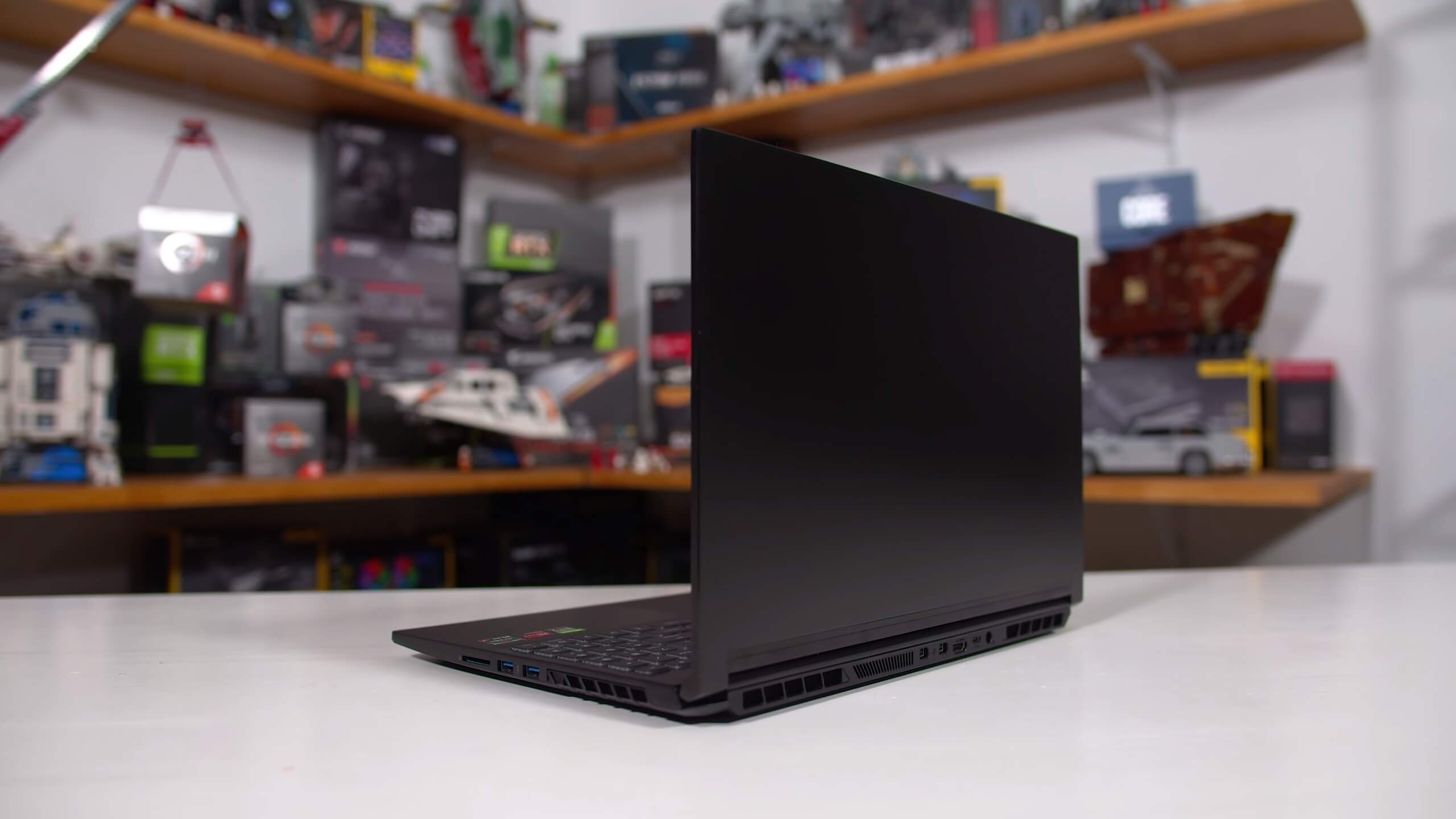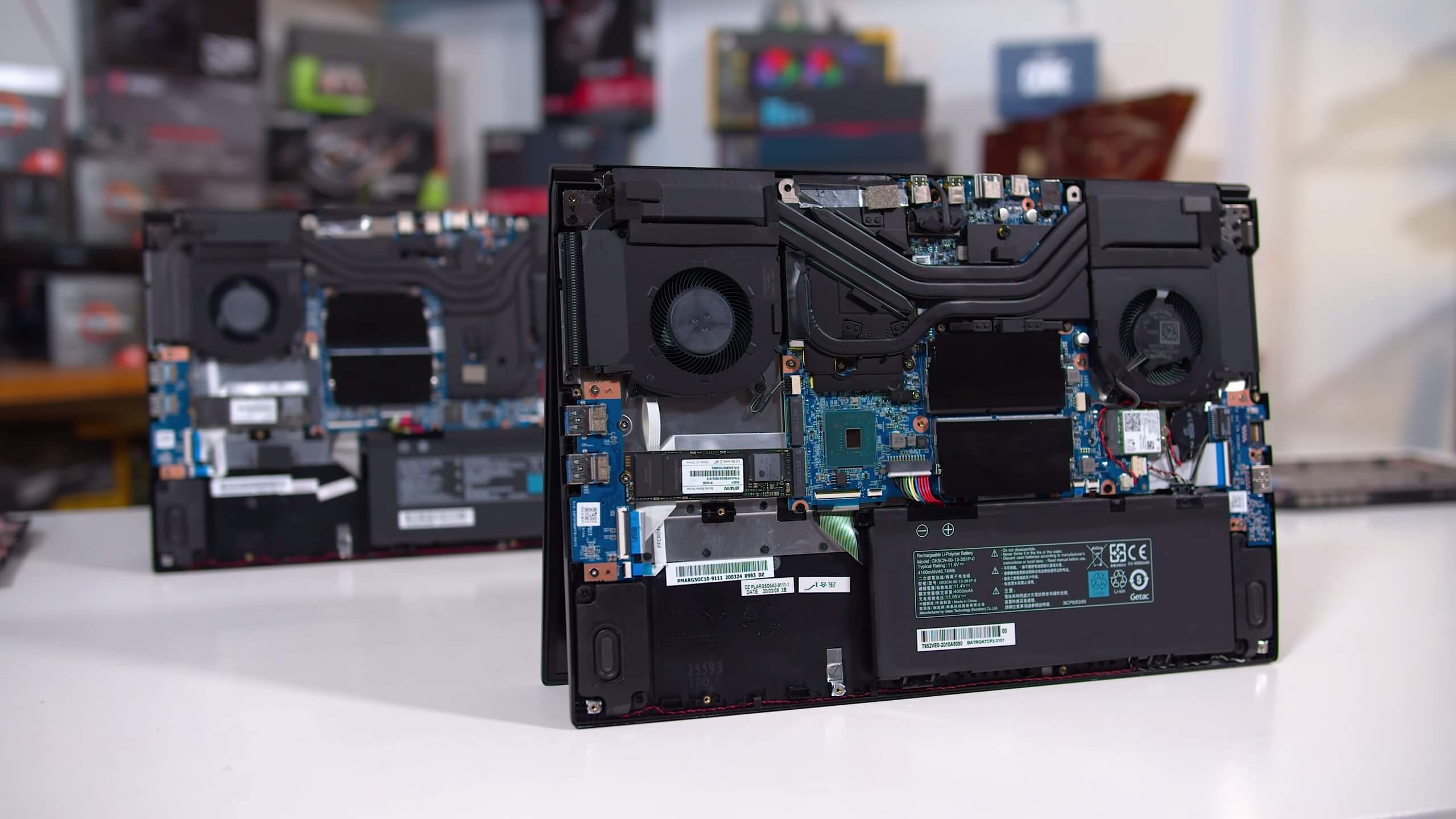You've seen the results of our numerous tests of Intel 10th-gen Core laptops as well as for AMD equipped models using Ryzen 4800H and 4900HS CPUs. Comparing them has been somewhat tricky however, as there are less laptops using AMD and often they're relegated to models that are either budget oriented or simply not offering top GPU options. While this may change in the near future, once AMD solidifies its position as a viable laptop CPU maker, that's the current situation.
Today's test is an exciting one for that same reason. Laptop maker XMG recently reached out to offer their machines for testing, saying they offered both Ryzen Mobile 4000 and Intel laptops... using the same design and chassis!
To be clear, the design in question isn't made by XMG, but comes from Chinese ODM Tongfang, who supply designs to many other laptop brands. XMG have branded this laptop as the Core 15, but you may have also seen it as the Eluktronics RP-15, among others. There are slight differences between what each brand offers, especially on the software and configuration side, but the baseline hardware is designed and manufactured by TongFang. XMG primarily sells into the European market.
So here we have the XMG Core 15, featuring the AMD Ryzen 7 4800H or the Intel Core i7-10750H. The remaining hardware is identical. Both ship with RTX 2060 GPUs, 16GB of dual-channel DDR4 memory, 512GB M.2 SSDs and identical 1080p 144Hz IPS displays. You can configure these systems to your liking, but for this review we're using the two closest configurations possible.
This allows for some very interesting benchmarking: for the first time we can definitively do an apples-to-apples comparison of an AMD and Intel laptop configuration in the same design, from an OEM that has spent a significant amount of effort optimizing the experience of both. This isn't a quick hack job to swap out Intel for AMD components, TongFang and XMG have put in a serious amount of work to ensure each laptop delivers the highest performance possible with this chassis.
In today's review we'll be covering productivity performance, a look at thermals, and battery life. In a follow up piece we'll dive into gaming performance with this design (part 2 is now live). The big difference between this review and our previous tests is that we aren't sticking to stock performance, or comparing the same power limits. Instead, we are seeing exactly what an AMD vs. Intel configuration can do when pushed to the limits with a similar thermal design. Does Intel benefit more from a higher power limit? Can AMD take advantage of higher efficiency? We'll explore all of that.
The Laptop
Before going into the benchmarks we want to look at the XMG Core 15, both inside and out, and comment on component differences. While these laptops are built from the same fundamental platform, as you might expect there are considerations made to optimize for AMD and Intel processors.
On the AMD side, using a Ryzen 7 4800H, TongFang has pushed up the power limit of this APU well above AMD's stock values. When using the Overboost mode, the CPU runs at up to 72W, the first time we've seen a Ryzen laptop exceed the rated TDP range AMD specifies. Intel laptops have been doing this for years, so it's great to see an AMD platform being given the same treatment in terms of power delivery and optimization. And this isn't just a 72W boost period, this is a long term limit of 72W.

The AMD-based Core 15 also features DDR4-3200, meeting AMD's memory spec. And the GeForce RTX 2060 is given a maximum power limit of 110W in the Overboost mode. No crappy display here either. The BOE panel has full sRGB coverage and good response times, which make it well suited to both gaming and content creation.
On the Intel side, the Core i7-10750H can be run up to 75W, so slightly higher than the AMD model. While the laptop itself uses the same DDR4-3200 memory modules, we're limited to DDR4-2933 per Intel's memory spec. The major difference is the RTX 2060 is capped to just 100W, not 110W like in the AMD model. Why the difference? This is what XMG told us: "this is due to the higher power efficiency of the AMD CPU - it leaves more headroom for GPU boost."
Both laptops came configured with 46 Wh batteries. When XMG ships these systems they will be configured with 62Wh cells instead. Also, our Intel unit had a Panda 120Hz panel instead of the BOE panel XMG ships for this device by default, so while the two displays may look a little different on camera, XMG says that both the AMD and Intel models actually ship with the same BOE display to final customers.
You might also be wondering, why aren't you comparing an AMD 8-core CPU to an Intel 8-core CPU? Using a Core i7-10750H is a bit of an imbalance in configurations when the Core i7-10875H exists. Well, the Core 15 is not available in a 10875H model. And also, despite the AMD design featuring more cores, it's the cheaper of the two at around 1450 euros, versus 1540 euros for the Intel model, using the same configuration.
The XMG Core 15's external design uses a nice metal chassis for the upper base and display area, it's reasonably slim and light although not a standout in either area, and it has a keyboard and trackpad combination that is great to use. Nothing overly fancy here, it's a good design.
Most importantly for our test, the vent system is the same on both Intel and AMD models. And there are a lot of vents here. TongFang have thought very carefully about how to get adequate airflow into the cooler, so there are huge vents directly over the fan intakes, open exhaust ports on three sides and even some ventilation over the heatpipes which you can see from the underside of the chassis.
The internal layout for each model is largely the same in terms of peripheral locations: all the I/O, SSDs, battery, Wi-Fi card and fans are in the same location. But there are some notable differences for the main components. On the Intel model, the GPU is on the left, with the CPU and RAM positioned on the right. You'll spot the H-series PCH in the bottom left as well, a component that isn't seen for the AMD system as all I/O functions are integrated into the Ryzen APU.
The AMD model has the APU and RAM on the left, with the GPU on the right. This leads to some heatpipe layout differences, although the fans and heatsinks are the same. The AMD model has two shared heatpipes for the APU, two shared heatpipes for the GPU, and two dedicated GPU heatpipes. The Intel model has three shared heatpipes for the CPU, three shared heatpipes for the GPU and one dedicated GPU heatpipe. Both models have a heatpipe that connects the left and right coolers. Looking at the layouts, it doesn't appear like one design is better than the other, there's simply a difference in approach that likely takes into consideration the strengths of each platform.
Both designs have direct cooling for both GPU and CPU VRMs, as cooling these components is very important. TongFang even thought of SSD cooling, so the M.2 slots have a metal heatspreader that dissipates heat into the chassis.
Benchmarks
Now let's get into some actual benchmarking, starting with Cinebench R20. Here the clear advantage goes to the Ryzen configuration in the multi-thread test: with 72W of power available, the XMG Core 15 is the fastest Ryzen 7 4800H laptop we've tested, and it pulls 60% ahead of the Intel configuration with its 75W Core i7-10750H. In fact, the 4800H is within striking distance of a desktop Ryzen 7 3700X in this test, we're getting 95% of the performance of that chip.

However the Intel configuration is faster in the single-core workload, 4% faster. This carries across to some single-thread workloads like Adobe Acrobat PDF exporting, which we won't show in detail today but the Intel model is 12% faster in Acrobat, the highest difference we saw in a single-thread test.
The AMD laptop also holds a dominant performance lead in Handbrake, or other CPU-only video rendering workloads. The power-boosted 4800H is 49% faster in this test than the power-boosted 10750H, showing that within the same chassis, there is a significant advantage to having Ryzen this generation compared to Intel. You'll see similar results in Blender where the AMD system just dominates multi-core performance.


In shorter, more boost-heavy workloads, it's still advantageous to have the Ryzen configuration, although not to the same extent. In Excel, the 4800H model is 8 percent faster, and in MATLAB it's 7 percent faster. In 7-Zip the difference depends on whether you are doing compression or decompression. The 4800H model is 54% faster for decompression, but just 11% faster for compression.



You'll also want the Ryzen model for code compilation. In our Cygwin compile, the AMD system pulled ahead by a significant 42 percent.


Meanwhile for Chromium compilation, AMD also has an advantage here, of about 17 percent. This isn't a situation where Intel can simply raise the power limit to match AMD, as TongFang have also boosted the AMD part when designing these machines.
CPU + GPU Workloads
What we were most interested in was to explore performance when the workload has a mixture of CPU and GPU utilization. Both laptops have the same GPU, the AMD model has a slightly higher power limit on the GPU, and both machines overall have a similar thermal solution. So which is the better choice in workloads like Photoshop, Premiere and DaVinci Resolve?

Adobe Photoshop gets a clear win to the Intel machine. One of the rare wins, although as Photoshop is lightly-threaded it makes sense that the system with higher single-thread performance would come out on top. The AMD system is just 3 percent slower so for someone buying a system for a mixture of productivity, this margin may not be significant enough to warrant going exclusively with the Intel model, but for pure Photoshop users, the Intel system is faster in the Puget benchmark.

For Adobe Premiere work, the AMD model is clearly the superior option. For live playback of clips in the timeline, the AMD configuration is 14% faster in the Puget workload. It's also around 14% faster for exporting videos in the Puget benchmark, not the same huge margin we saw for CPU-only encoding, but faster is still faster. We suspect the Intel system has gained ground here as although most of the encoding work can now be done on the Nvidia GPU, Premiere still seems to better utilize the Intel iGPU for periphery tasks like video decoding.


For two-pass encodes, which are CPU-only, the AMD system held a 30 percent advantage, so if you want to up the quality of your exports, the margin will only grow in favor of AMD. The AMD model was also faster when warp stabilizing, about 12 percent faster for a single instance. Due to its higher core count design, we suspect this would also favor AMD if you were running multiple instances simultaneously.

And finally we have the DaVinci Resolve benchmark, where once again the AMD system is the better choice. We're not seeing a massive margin, but the AMD model is 11 percent faster overall, owing to a more efficient CPU design and slightly higher power allocation to the GPU.
Putting It All Together
On average, looking across our entire suite of productivity workloads, the AMD model comes out 19 percent faster. However the actual performance difference you see can be drastically different depending on the workload. In pure CPU-only multi-threaded tests, the AMD model is up to 60 percent faster. In key CPU+GPU workloads you can expect a 10 to 20 percent advantage to the AMD configuration. And then Intel holds the single-thread performance crown.

In terms of thermals and noise output, there isn't much separating the two in a CPU-only workload like Handbrake.
Noise output was within the margin of error which is no surprise given both have the same fans and heatsink combination, with both systems running in the same Overboost mode, presumably with the same fan controls.

The AMD system did run slightly hotter on its reported sensor, at 90C versus 85C for the Intel model, however there are question marks over how comparable these numbers are, given they are from different types of sensor. As fan noise is the same and neither system throttles, and package power was also within 3W for both models, there is no real world thermal system advantage for either model. But that's to be expected given TongFang has tuned each configuration to use as much power as is possible with this thermal design. We'll look at combined CPU + GPU thermals in our gaming investigation (now live).
Battery Life
We got a brief look at battery life, which for this sort of gaming-focused system is never going to be amazing. The first test was streaming 4K HDR H.265 video over Wi-Fi using VLC, with both models configured at the same brightness level. In this video streaming test, the AMD model was a bit more efficient and able to last longer, about 25% longer, with the same battery capacity.

What was most interesting is to compare battery life and performance when running our Handbrake workload on battery. Performance drops off considerably, with the CPU maxing out at 30W on the Intel system, and just 25W on the AMD system - less than half the power the laptop will consume when plugged in.
However, the Intel system is actually unable to complete the workload on battery, dying just after one hour of use with only 76% of the video encoded. The AMD system in comparison, takes just 43 minutes to encode the video, and finishes with 38% of its battery remaining. When you extrapolate this result, the AMD system would only last about 10 percent longer under a sustained high performance workload, but because it's so much faster at a given power level, it can just do more in that time.

This is a great example of how a more efficient CPU design can benefit laptop buyers. Slamming the CPU under full load, yeah there's not much separating Intel or AMD. But what the Ryzen APU allows you to do, is do more with the time you have. In some instances this ability to return to idle sooner will extend battery life, in others it means you can fit in more tasks into the battery capacity of your device.
What We Learned
At the end of the day, we already knew that AMD's Ryzen 7 4800H is faster than a Core i7-10750H under stock conditions. But what we saw in today's review is exactly how that difference translates to real world devices for productivity workloads with an otherwise identical configuration.
A key factor here is that XMG doesn't have an unbalanced line-up where the Core 15 Intel model receives a power boost, while the Core 15 AMD model is stuck at stock power. XMG and TongFang have put enough time into optimizing both systems, and it shows. With time, we expect other laptop makers to do the same. AMD does not have the greatest record as a laptop CPU provider, even with previous Ryzen generations, those systems were just ok and Intel was the superior choice.
AMD is finally delivering on laptops with the Zen 2-based Ryzen 4000 series which is more efficient than the Intel alternative at ~45W stock power levels and when boosted up near 75W. We've only seen Intel matching AMD this generation with an unbalanced power configuration, and for achieving the feat, the Intel CPU usually needs to suck down twice as much power. In laptops with limited cooling capacity, it's simply not possible to give the Intel CPU the power to normalize performance without making the system larger.
There are other benefits. too. Longer battery life, or the ability to do more within a certain threshold. Thermally there isn't much difference at maximum performance (as you'd expect), so the AMD system has much greater scope to deliver acceptable performance at lower noise levels. For example, we had the XMG AMD laptop running with a silent fan profile and Eco mode enabled, and it almost matched the full power Intel system in Cinebench R20 performance, all with virtually no fan noise.
There is no doubt that in this comparison the XMG Core 15 with Ryzen 4000 inside is the better laptop for most productivity workloads. The fact that it even saves you some money should seal the deal. This is a really nice laptop, with an excellent cooling solution, decent display, nice selection of ports and a well-constructed design. This is the first XMG laptop we've tested and we were genuinely impressed with the quality and optimization, so if they're available in your region, you should definitely check it out.
Part two: Ryzen 4000 vs. Intel 10th-gen Gaming Battle






